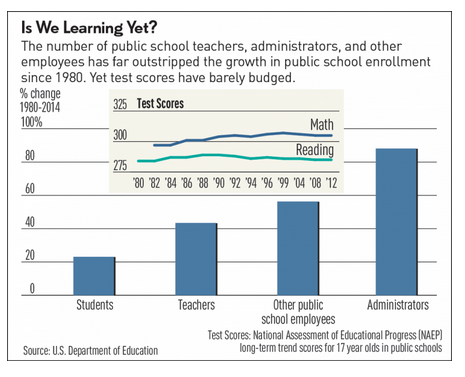Last week Investor’s Business Daily posted an editorial explaining how the proposed tax bill might impact educational spending.
The editorial included the following chart:
 As you can see from the chart, the number of administrators in education has risen much faster than the number of teachers and students, while test scores have remained essentially the same. It is definitely time that we examined our priorities in education spending,
As you can see from the chart, the number of administrators in education has risen much faster than the number of teachers and students, while test scores have remained essentially the same. It is definitely time that we examined our priorities in education spending,
The editorial also points out how the tax bill under consideration might impact education spending:
The National Education Association blasted the GOP tax reform plan saying that eliminating the state and local tax deduction for those who itemize taxes would be a severe blow to schools, putting 250,000 education jobs at risk.
“It would,” says NEA president Lily Eskelsen Garcia, “jeopardize the ability of state and local governments to fund public education. That will translate into cuts to public schools, lost jobs to educators, overcrowded classrooms that deprive students of one-on-one attention, and threaten public education.”
There are other provisions in the tax bill that might worry teachers’ unions, such as letting parents use 529 college savings plans to pay for elementary and secondary school costs. That would help make private schools more affordable — a small step toward encouraging school choice.
But it’s the so-called SALT deduction that has the unions up in arms. Why? Because getting rid of it might force high-tax states — which benefit the most from the deduction — to cut taxes and rein in their own spending.
Of course, that’s pure speculation on the NEA’s part. States won’t be obligated to change anything if the SALT deduction goes away.
I think we need to understand that the Trump Administration is generally a goal-oriented group and sometimes their goals are very subtle. The Secretary of Education is a proponent of school choice, and it seems as if the tax proposals might also encourage school choice. The public schools are not doing their job of educating our children, and parents are becoming more willing to find alternative solutions. The amount of children being home-schooled has rapidly increased in recent years. Part of this is due to the fact that test scores have not improved, and part of this is due to the fact that the schools are teaching children values that in many cases contradict the values of their parents.
It would probably be a really good idea to take a look at where our education dollars are being spent. Somehow our students managed to learn more before there was a federal Department of Education.


